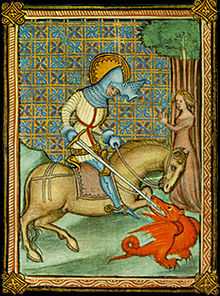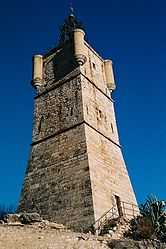Draguignan
| Draguignan | ||
|---|---|---|
|
Clock tower of Draguignan. | ||
| ||
 Draguignan | ||
|
Location within Provence-A.-C.d'A. region  Draguignan | ||
| Coordinates: 43°32′25″N 6°28′00″E / 43.5403°N 6.4667°ECoordinates: 43°32′25″N 6°28′00″E / 43.5403°N 6.4667°E | ||
| Country | France | |
| Region | Provence-Alpes-Côte d'Azur | |
| Department | Var | |
| Arrondissement | Draguignan | |
| Canton | Draguignan | |
| Intercommunality | Draguignan | |
| Government | ||
| • Mayor (2008–2014) | Max Piselli | |
| Area1 | 53.7 km2 (20.7 sq mi) | |
| Population (2006)2 | 38,258 | |
| • Density | 710/km2 (1,800/sq mi) | |
| INSEE/Postal code | 83050 / 83300 | |
| Elevation |
153–603 m (502–1,978 ft) (avg. 181 m or 594 ft) | |
|
1 French Land Register data, which excludes lakes, ponds, glaciers > 1 km² (0.386 sq mi or 247 acres) and river estuaries. 2 Population without double counting: residents of multiple communes (e.g., students and military personnel) only counted once. | ||
Draguignan (French pronunciation: [dʁa.ɡi.ɲɑ̃]) is a commune in the Var department in the Provence-Alpes-Côte d'Azur region, in southeastern France.
It is a sub-prefecture of the department and self-proclaimed "capital of Artillery" and "Porte du Verdon".
The city is 42 km (26 mi) from St. Tropez, and 80 km (50 mi) from Nice.
City's name

According to legend, the name of the city is derived from the Latin name “Draco/Draconem” (dragon): a bishop, called Saint Hermentaire, killed a dragon and saved people.
Motto
The Latin motto of Draguignan is Alios nutrio, meos devoro (I feed others, I devour my children).
Geography
The elevation is 200 m. The highest hill near Draguignan is Malmont (551 m). The main river near Draguignan is the Nartuby.
The city is set in a valley NW-SE, about 2 km (1 mi) wide.
History
- The name of Draguignan (“Dragonianum”) appeared for the first time in 909.
- During the Middle-Ages, Draguignan was a small village whose people lived from olive and grape cultivation.
- Draguignan became the “prefecture” of the Var in 1790, at the beginning of the French Revolution. This was despite the town by far not being the biggest city in the department. It remained the seat of the prefecture until 1974.
- In the 19th century and during a large part of the 20th century, the people of Draguignan (in French: “Dracénois”, in English: “Draceners”) voted for liberal parties (Radical-Socialist Party, Socialist Party).
- The town was occupied by the Wehrmacht in 1942-44 and freed in August 1944, after Operation Dragoon.
- The city welcomed the “Ecole nationale d'artillerie” (Artillery School) in 1976, then the “Ecole nationale d'infanterie” (Infantry School) in 2010. The arrival of the military involved the development of the city : the small town became a city in the second part of the 20th century : 13 400 citizens in 1954, 33 000 in 2000, 38 000 in 2010.
- On June 15, 2010, the city was flooded. Torrential rain caused the deaths of 12 people in the town and 25 in the neighborhoods.
Major attractions
- Museum of Artillery (Napoleonic wars, World War I, World War II, Indochina, etc.)
- Museum of "Arts et traditions populaires"
- Rhone American Cemetery and Memorial (American WWII cemetery) (see operation Dragoon)
- The Eglise St Michel
- Eglise Notre-Dame du Peuple
- The Dolmen Pierre de la fée (fairy's Stone), also known as the fruit rock.
Personalities connected to Draguignan
- Georges Clemenceau, was a politician of Draguignan : deputy of the district of Draguignan (1885–1893) and senator of the same district (1902–1920), French prime minister in 1906-1909 and 1917–1920
- Émile Ollivier, was a politician of Draguignan : deputy of the district of Draguignan, then prime minister in 1870
- Maximin Isnard, was a politician of Draguignan
- Georges Thill, died in Draguignan
- Lily Pons, born in Draguignan
- Claude Gay, born in Draguignan
- Abel Douay, born in Draguignan
- Hippolyte Mège-Mouriès, born in Draguignan
- Alain Connes, born in Draguignan
- Ivan Pavlak, born in Draguignan
- Michaël Fabre, born in Draguignan
- Nicolas Agnesi, born in Draguignan
- Charlotte Morel, born in Draguignan
- Michel Constantin, died in Draguignan
- Jean-Marie Auberson, died in Draguignan
- Louis Moréri, studied in Draguignan
- Gustave Ferrié, studied in Draguignan
- Philippe Seguin, studied in Draguignan
- Michel Lafourcade, died in Draguignan
- Ronald Searle, British artist, died in Draguignan
- Henri Mulet, French organist and composer, spent the last 30 years of his life in Draguignan, as organist of the cathedral there.
- Karl Amoussou Karl "Psycho" Amoussou is a MMA fighter in Bellator Fighting Championships. born in Draguignan.
Twin towns
Pictures
-
The Dolmen Pierre de la fée.
-

The Town Theatre of Draguignan (Théatre Municipal).
-

The old Railway Station, which is still called Gare SNCF even though the tracks from Les Arcs to Draguignan were dismantled or closed down.
See also
- Communes of the Var department
- List of Draguignan's mayors since 1800 (in French)
- List of Draguignan's streets (in French)
- List of works by Auguste Carli
References
External links
| Wikimedia Commons has media related to Draguignan. |
- City council website (in French)


